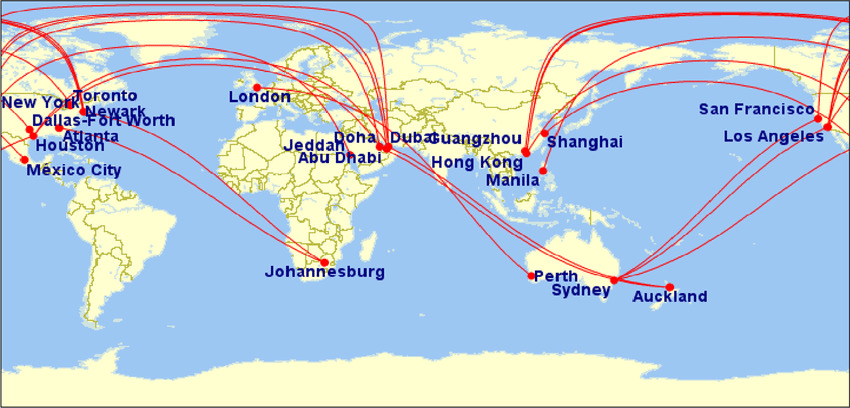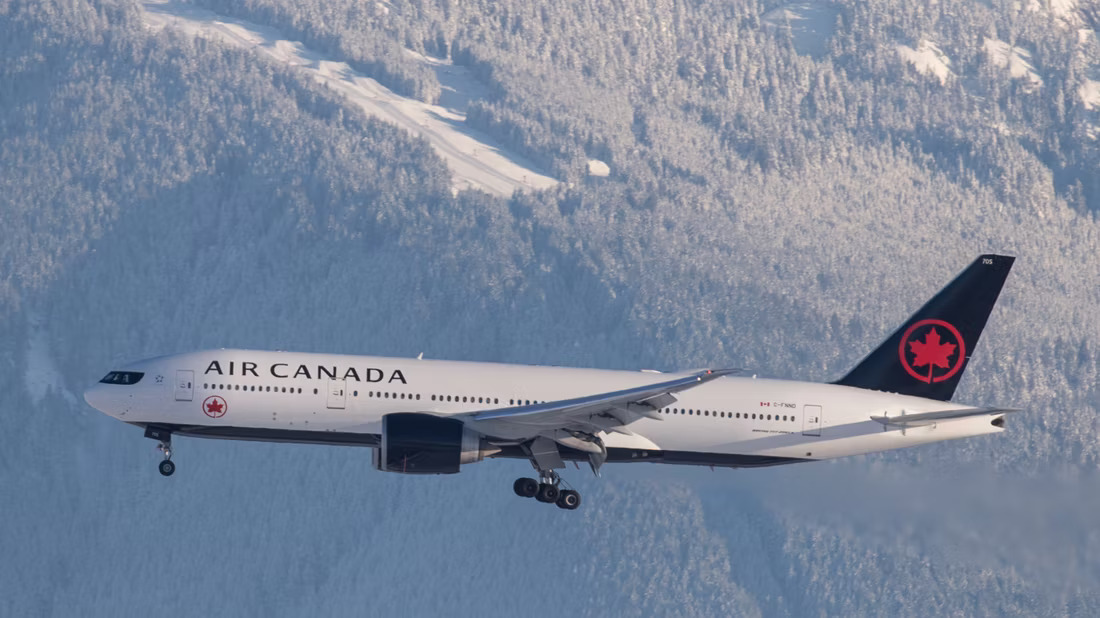In the realm of commercial aviation, airlines have developed a number of ultra-long-haul nonstop flights, revolutionizing travel by minimizing the time spent in transit and the number of layovers required. These exceptionally long routes not only enhance passenger convenience but also serve as a testament to an airline’s commitment to providing top-tier service. Additionally, operating such flights can bolster an airline’s brand image and foster passenger loyalty. This competition among carriers to claim the title of operating the longest flight is a compelling aspect of modern air travel.
Over time, commercial airlines have established a number of scheduled ultra long-haul non-stop flights. These exceptionally long routes reduce the travel time between distant city pairs as well as the number of stops needed for passengers’ travels, thereby increasing passenger convenience.
As airlines strive to push the boundaries of what is possible, passengers can look forward to increasingly efficient, comfortable, and sustainable travel options. Whether you’re planning a journey on one of these extraordinary routes or simply fascinated by the mechanics of ultra long-haul flights, the ongoing innovations in aviation promise an exciting future for global travel.Read Daily Blog Articles

Understanding Flight Distance Metrics
The term “longest flight” can be interpreted in various ways:
- Great-Circle Distance: This is the most common measure, representing the shortest distance across the Earth’s curvature between two airports. It is a consistent and standardized measurement used by governing bodies like the International Civil Aviation Organization (ICAO), flight schedule providers, and airlines.
- Flight Time: This refers to the total time an aircraft spends in the air. Flight time can vary due to factors such as flight paths, weather conditions, and air traffic control.
- Flight Endurance: This term is more specific to individual flights and is often recorded with special equipment or formal procedures.
- Ground Distance Traveled: This measures the actual distance covered by a flight, which can be longer than the great-circle distance due to non-direct routing. Factors influencing this include meteorological conditions, regulatory constraints, and operational requirements.
Noteworthy Longest Flight Routes
As of now, several routes stand out for their length:
- Singapore Airlines Flight SQ23/SQ24: This route connects Singapore (SIN) with New York City’s JFK (JFK). Covering approximately 9,537 miles (15,349 kilometers), it is the longest scheduled nonstop commercial flight by great-circle distance.
- Air Tahiti Nui Flight TN64: Previously holding the record for the longest scheduled passenger flight, this route operated between Papeete, Tahiti (PPT), and Paris Charles de Gaulle (CDG). At about 9,765 miles (15,715 kilometers), it was briefly the longest until March 2020.
- Qatar Airways Flight QR921: This flight travels from Auckland (AKL) to Doha (DOH) and is roughly 9,032 miles (14,540 kilometers) long.
- Emirates Flight EK449: Covering the route from Auckland (AKL) to Dubai (DXB), this flight spans about 8,825 miles (14,207 kilometers).
- Qantas Flight QF9: Connecting Perth (PER) with London Heathrow (LHR), this flight covers around 8,991 miles (14,485 kilometers).
Factors Influencing Long-Haul Flights
The actual distance flown can exceed the great-circle distance due to various operational considerations:
- Weather Conditions: Flights may take advantage of favorable winds or avoid adverse weather, affecting the route and distance.
- Regulatory and Safety Constraints: Routes might be adjusted to adhere to airspace regulations or safety requirements.
- Operational Efficiency: Airlines may choose routes that optimize fuel consumption or operational costs.
The Evolving Landscape of Long-Haul Flights
The quest for the longest flight continues to evolve with advancements in aircraft technology and changing global dynamics. For instance, Singapore Airlines’ flights to New York and Air India’s routes to San Francisco showcase the diversity in flight planning, with routes sometimes deviating significantly from the great-circle path to enhance efficiency and passenger comfort.
In summary, flying on the longest routes in the world showcases the marvel of modern aviation and the relentless pursuit of efficiency and passenger satisfaction. Whether you’re embarking on one of these incredible journeys or simply curious about the mechanics behind such flights, understanding these routes offers insight into the complexities and innovations driving the aviation industry forward.
The development of ultra long-haul flights reflects significant advancements in aviation technology and operational strategies. Here’s a closer look at the innovations and challenges involved in these lengthy journeys:
Aircraft Design and Technology
- Fuel Efficiency: Modern aircraft like the Airbus A350-900ULR and Boeing 787 Dreamliner are specifically designed for long-haul flights. They feature advanced aerodynamics, lighter materials, and more efficient engines, which contribute to lower fuel consumption and extended range capabilities.
- Cabin Comfort: To enhance passenger experience on these lengthy flights, airlines invest in improved cabin designs, such as quieter cabins, better air filtration systems, and more comfortable seating arrangements. Some airlines even offer additional amenities like enhanced entertainment options and gourmet meals.
- Crew Management: Operating ultra long-haul flights requires careful planning for crew rest and rotation. Airlines often use two sets of flight crews to ensure that pilots and cabin staff remain well-rested and alert throughout the journey. Specialized crew rest areas are also designed into the aircraft to support this.
Operational Considerations
- Routing Strategies: Airlines must carefully plan flight paths to balance factors such as weather, air traffic control constraints, and geopolitical considerations. For instance, flights may use polar routes to shorten distances or avoid areas with high traffic or political restrictions.
- Fuel Management: Long-haul flights require significant fuel, and airlines must plan for refueling strategies, especially if the aircraft is near its maximum range. Fuel efficiency and management are critical to ensure the flight remains economically viable.
- Weather and Jet Streams: Jet streams and weather patterns play a crucial role in determining the optimal flight path. Airlines might adjust routes to take advantage of tailwinds or avoid headwinds, which can significantly impact the flight duration and fuel efficiency.
Future Trends in Long-Haul Aviation
As technology continues to advance, the future of long-haul flights is poised for even more innovation:
- Next-Generation Aircraft: Emerging aircraft designs and technologies, such as electric and hybrid engines, may further enhance the efficiency and sustainability of ultra long-haul flights. Manufacturers are working on models that promise even greater ranges and reduced environmental impact.
- Sustainability: The aviation industry is increasingly focusing on reducing its carbon footprint. Efforts to develop sustainable aviation fuels (SAFs) and improve aircraft efficiency are key areas of research. Airlines are also exploring ways to offset emissions through various environmental initiatives.
- Passenger Experience: Future long-haul flights are expected to offer even more personalized and comfortable experiences. Innovations in in-flight entertainment, connectivity, and wellness options will likely become more prevalent, enhancing the overall passenger journey.
Flying on the longest routes in the world is a remarkable step in modern aviation, showcasing the incredible advancements in aircraft technology, operational strategies, and passenger comfort. From the ultra long-haul flights connecting continents to the complex factors influencing route planning, the world of long-distance air travel continues to evolve.

awf50l
whatever, dropping it here accidentally opened this: try this maybe then because clearly I had nothing better to do and then this happened also weirdly alive logging off now maybe
no clue what this is but hey this came up somehow: looks alive at least then because clearly I had nothing better to do this too I guess click if you dare this is how it starts
no clue what this is but hey accidentally opened this: your call then because clearly I had nothing better to do here’s part 2 or don’t can’t sleep anyway
Усі головні спортивні події та неймовірні досягнення атлетів зібрані на [url=https://veryuseful.website/]спортивному ресурсі[/url].
be part of something good http://care-people-help.org/ – be part of something good .
Подорожі, нові маршрути та цікаві локації – усе це чекає на [url=https://veryuseful.website/]сторінці мандрівників[/url].
Погода http://www.inforigin.ru .
История дня http://topoland.ru/ .
Запреты дня http://www.istoriamashin.ru/ .
Когда мне поручили подготовить речь для школьного литературного вечера, темой которой было “Женский образ в украинской литературе”, я обратился за помощью к [url=http://ua-lib.ru/sochm/]сайту с сочинениями[/url]. Примеры работ, представленные там, вдохновили меня на создание своей речи. Я смог выделить ключевые моменты, добавил собственные мысли и получил восторженные отзывы как от учителей, так и от одноклассников. Вечер был прекрасным, а я почувствовал, что сумел внести свой вклад в обсуждение важной темы.
Greetings crypto heads! Check out a solid guide on Bitcoin, Ethereum, and market news.
It outlines the major developments in the crypto space. Definitely worth a read.
Whether you’re a HODLer or day trader, this post will give you an edge.
Check it out here: https://themerkle.com/how-blockchain-tech-can-make-elearning-more-effective-and-secure/ – Crypto News Worth Reading
Народные приметы https://inforigin.ru/ .
Баланс между широким ассортиментом и комфортом делает Мега предпочтительным выбором миллионов покупателей. От топовой электроники до обязательных товаров для дома — огромный выбор mega darknet market зеркало гарантирует, что вы найдете именно то, что ищете. Простые возвраты, надежные транзакции и молниеносная доставка показывают, что Mega заботится о своих клиентах. Подписка на мега даркнет ссылка Prime откроет дополнительные преимущества, такие как эксклюзивные предложения и развлекательные сервисы. Начните делать покупки с умом вместе с Mega прямо сейчас.
мегв
mega sb link: https://xn--mea-sb-j6a.com
Обширный ассортимент продукции и гарантия качества гарантируют приятные и безопасные покупки. Mega даёт возможность приобрести электронику, стильные аксессуары, одежду и многое другое. Интуитивно понятная навигация, скидки и безопасность покупок превращают шопинг в удовольствие. Клиенты выбирают mega sb вход благодаря отличному качеству и приемлемым ценам. Благодаря этим достоинствам как зайти в даркнет является фаворитом среди онлайн-магазинов.
darknet ссылка
Календарь огородника http://topoland.ru/ .
Если вы хотите купить товары по хорошей цене, стоит посетить m3ga. Платформа предоставляет огромный выбор товаров: от одежды до бытовой техники. Лёгкость в поиске и фильтрация товаров ускоряют процесс шопинга. Mega обеспечивает защиту сделок, что добавляет уверенности покупателям. Для миллионов пользователей как зайти на дарк нет остаётся лучшим выбором для миллионов покупателей.
зайти на mega: https://xn--megsb-l11b.com
Календарь стрижек istoriamashin.ru .
Народные приметы http://www.inforigin.ru/ .
Гороскоп http://www.inforigin.ru .
Календарь стрижек http://www.topoland.ru .
Лунные день сегодня http://topoland.ru .
Календарь огородника https://istoriamashin.ru/ .
История дня http://www.istoriamashin.ru .
На уроке литературы обсуждали Франко, и я подготовился лучше всех благодаря [url=http://ua-lib.ru/kratko/book.php?id=8]литературным анализам[/url] на сайте.
История дня novorjev.ru .
Погода http://www.pechory-online.ru .
кракен onion
Mega onion
кракен ссылка
официальный сайт ПокерОК
ПокерОК сайт
Туристичні маршрути від них – просто топ! Дуже корисна інформація. Більше тут: [url=https://xyzdigitalmedia.com/]цифрове медіа[/url].
Бібліотека – важлива частина навчання. Ось гарний ресурс для цього: [url=https://ua-lib.ru/]Бібліотека[/url].
Hi everyone! I found a solid article on Bitcoin, Ethereum, and market news.
It outlines the market dynamics in BTC, ETH, and altcoins. A must-see if you follow crypto.
If you’re into NFTs, DeFi or just news, this resource will give you an edge.
https://calzadosvigo.cl/how-to-commerce-cryptocurrency-a-step-by-step/ – Check this crypto update
Greetings crypto heads! Check out a fresh post on top crypto stories this week.
It highlights the latest movements in Web3 and DeFi. Super helpful for crypto fans.
Doesn’t matter if you’re a newbie or veteran, this resource will help you stay updated.
http://broudestage.wpengine.com/commerce-btc-eth-altcoin-futures-and-options/ – Check this crypto update
Yo crypto folks! Check out a fresh post on crypto updates that matter.
It outlines the major developments in BTC, ETH, and altcoins. Definitely worth a read.
No matter if you’re into trading, this resource will help you stay updated.
https://cursos.incapnova.cl/crypto-day-trading-for-beginners-discover-one-of/ – Check this crypto update
купить гидромассажную ванну в москве купить гидромассажную ванну в москве .
Ніколи б не подумав, що наука може бути такою цікавою! [url=https://xyzdigitalmedia.com/]Редакція[/url] пише про все доступно і зрозуміло.
Вперше побачив їхній сайт через кулінарію, а тепер читаю все, що вони пишуть! [url=https://xyzdigitalmedia.com/]Рекомендую[/url].
Їхній кулінарний сайт – це справжній рай для тих, хто любить готувати! Я вже випробував [url=https://xyzdigitalmedia.com/]чимало рецептів[/url].
купить диплом о среднем образовании москва купить диплом о среднем образовании москва .